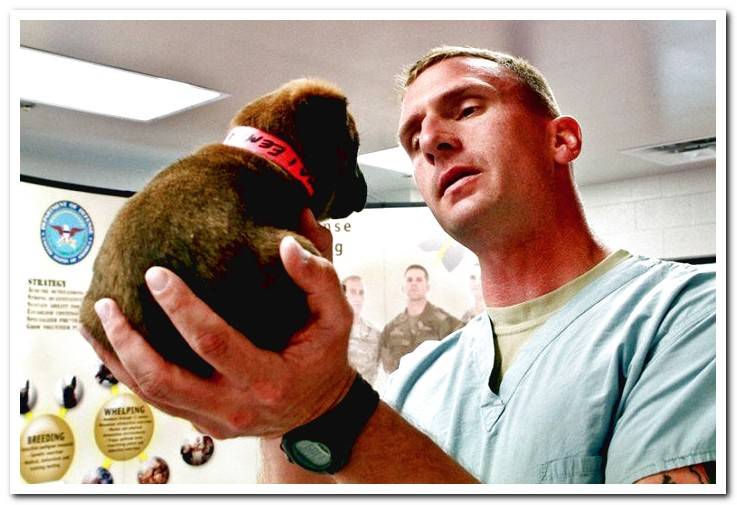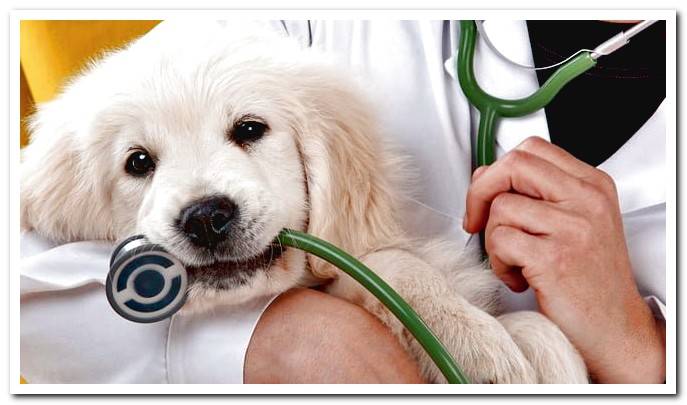
Distemper is a viral disease that affects mostly unvaccinated puppies and can be fatal. Since viruses cannot be eliminated, treatment can only be supportive.
That is why the prevention that we are going to be able to do is based on a correct vaccination schedule. Next we will explain the characteristics of this disease.
- You may also like: When to vaccinate a dog
Index of contents
- 1 What is canine distemper?
- 2 Canine distemper symptoms
- 2.1 First stage
- 2.2 Second stage
- 3 Plantar hardening
- 4 How is canine distemper spread?
- 5 How is canine distemper diagnosed?
- 6 What dogs does canine distemper affect?
- 7 Canine distemper treatment
- 8 Recommendations for caring for a dog with distemper
- 9 What is the prognosis of canine distemper?
- 10 How to prevent canine distemper
- 11 How does the canine distemper vaccine work?
What is canine distemper?
Distemper, also known as distemper, is a very contagious pathology that is caused by a family virus Paramyxoviridae, similar to the one that in people triggers measles. It is worldwide, although in countries where dogs are vaccinated regularly, cases are less frequent.
Not all dogs in contact with the virus are going to show clinical signs or can do it, but they are very slight. This is due to the state of health from which each specimen starts, which reminds us of the importance of good nutrition, deworming, care and vaccines so that the immune system can fight the virus.
This attacks especially the cells of the brain and those of the body surface such as those of the skin, the mucous membranes in the respiratory or digestive system, the eyes, etc. In each case, depending on the organs that are most affected, we will detect different symptoms. In addition, the presence of the virus weakens the animal, so there are usually secondary infections.

Canine distemper symptoms
The clinical picture corresponding to this disease is presented, approximately, one week after contact with the virus. Its development can be divided into several stages that we will detail in the following sections.
First stage
It is characterized by the appearance of fever, which can become high. The dog stops eating, is listless and emits a watery discharge from the eyes and nose, which gives the disease its name and can make us mistake it for a cold. The discharge eventually thickens and takes on a yellowish color.
There is also a dry cough and vomiting and diarrhea of considerable intensity. The dog can become dehydrated. If at this time we go to the vet and we are prescribed a treatment, it is possible that the dog improves, but he will relapse. It is the second stage of the disease.
Second stage
About 2-3 weeks after the first stage appears, the disease will affect the brain. We will detect it by symptoms such as hypersalivation, chewing movements or head shakes. Some dogs appear to have epileptic seizures, run in circles, fall down, snap with all four legs, etc.
When they recover from these crises they seem disoriented, they give the impression of not seeing and seek to hide. It is also characteristic the known as distemper myoclonus, disorder in which rapid and rhythmic contractions occur in any muscle of the body, but especially in the head. The myoclonus appears day and night.
In this state the dog will feel pain, which we will perceive because it moans and howls. These contractions can persist even when the dog recovers, but in a milder way.

Plantar hardening
Also known as hyperkeratosis of the plantar bearings and the nasal epithelium. It is a form of distemper caused by another strain of the virus that damages the skin of the feet and the truffle. It thickens and hardens. It appears fifteen days after the infection started. It is a rare presentation.
How is canine distemper spread?
The distemper virus is released into the environment in all body secretions of infected dogs. The most common way of contagion is inhalation of the virus, since dogs often sniff urine and stools from their congeners.
For this reason, it is essential that unvaccinated pets do not circulate through the transit areas of other dogs whose health status is unknown or whether or not they are vaccinated. A recovered dog can continue to clear the virus for about 4-6 months.

How is canine distemper diagnosed?
Taking a blood sample, the presence of the virus can be checked. The vet sends it to an external laboratory, where it is possible to perform various techniques, or uses a rapid detection kit in the clinic itself, taking a sample from the conjunctiva or nose.
Of course, false negatives can occur, so it will also be necessary to attend to the clinical picture, its evolution and response to treatment. In addition, at a minimum, blood tests will be needed to know the general condition of the dog.
When damage to the brain appears and there are other pathologies that could cause it, it can be used to diagnose an analysis of cerebrospinal fluid, which is the one that bathes the brain and spinal cord.
What dogs does canine distemper affect?
Although potentially any dog could get distemper, those most at risk of getting sick are all those who have not been vaccinated. For this reason it is a pathology that we will see more frequently in puppies, with immune systems still immature and without having the vaccination schedule complete.
Within this group, those with the highest incidence of the disease are unvaccinated puppies between 6 and 12 weeks of age. This is so because it is the moment when the defenses that the mother has transmitted to them descend and the required doses of vaccines have not yet been completed.
It is important to know that this disease is specific to dogs. Therefore, although it is highly contagious among them, other animals that live with it they will not be affected, even being in close contact. The exception are ferrets. People do not suffer from this disease.
Canine distemper treatment
The first thing we should know is that there are no home remedies to combat distemper. In fact, this disease will require intense veterinary treatment. It is also important that we go to this professional at the first symptom. Any cold in an unvaccinated puppy is suspected of distemper.
In addition, since it cannot kill viruses, the objective is to establish a supportive treatment with the administration of intravenous fluids to keep the dog hydrated, antibiotics to avoid secondary infections and drugs aimed at controlling the different symptoms that appear as vomiting. , diarrhea, or seizures.
Recommendations for caring for a dog with distemper
Typically, the start of treatment requires the dog to enter to receive specialized care and control. If the animal improves, the vet will discharge him and we will continue to take care of him at home.
These are the recommendations to follow:
- Of course, scrupulously administer the medication that the vet has prescribed for us and follow their instructions.
- It is normal that the appetite is decreased, so we can offer the dog wet food specially formulated for convalescent animals or a home menu to your liking like cooked chicken or ham, always without salt or sauces.
- Tempering food encourages an inattentive dog to eat.
- It is not a time for bathing, although we do have to clean it locally if it gets dirty from vomiting, diarrhea, secretions or when eating.
- Keep it in a comfortable bed, at the right temperature and away from drafts or cold.
- If there are other dogs at home without vaccinating we must avoid contact isolating the sick.
- Disinfect beds, utensils and surfaces. The virus in the environment is easily deactivated and can only withstand a few weeks in cold climates with temperatures between 0-4 ºC.

What is the prognosis of canine distemper?
We know that distemper is a serious disease that can be fatal for our dog. But it is impossible to determine if a sick animal is going to be cured or not because that depends on multiple factors.
When the treatment has started, the virulence of the virus, the age of the virus, its vaccination status and how its immune system responds are the points that will influence the prognosis. Neurological involvement worsens the prognosis.
How to prevent canine distemper
Given the severity of the disease, the inability to eliminate the virus, and the possible fatal consequences, the option is to prevent rather than cure. For this it is essential that let’s vaccinate our dog following the schedule proposed by the vet and adapted to your life circumstances.
The effectiveness of the distemper vaccine it is very high. All puppies must be vaccinated and adults need revaccination at least every three years, although this vaccine is usually included in the annual revaccination. Of course, no vaccine is 100% effective. Vaccinated dogs may get distemper, albeit in a milder way.
How does the canine distemper vaccine work?
Like any other vaccine, its mechanism of action is based on presenting the virus to the body, but in an attenuated way. This is accomplished using viral fragments, inactivated viruses, or live viruses. By putting the vaccine, the animal’s immune system reacts by attacking the pathogen that we administer and create memory antibodies.
Thus, if the dog came into contact with the virus due to natural circumstances, in this case distemper, it would immediately receive the attack of an immune system that already has specific cells with which to fight it. Without the vaccine, a first contact with the virus can kill the dog if its body does not have time to create these defenses.
A dog that has managed to recover from distemper should also be vaccinated because passing the disease only ensures protection for two to three years. Therefore, it could become infected again.
